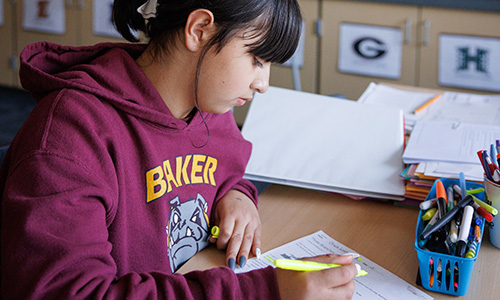
When I was in school, I learned about the writing process in a way that made it seem linear. In my mind, it was akin to a drive along an interstate: long, mostly flat, and straight, with only occasional diversions to be had. As an adult, my approach to the writing process looks like a map of the greater Los Angeles area: dizzying swoops and tangles of freeways, long boulevards carving their way through multiple cities, detours, attractions, and frequent instances of traffic at a complete standstill.
When I started college, it did not take me long to discard the linear approach to the writing process I had adopted so dutifully in school. Outlines? Please! Formal drafts? Ha! Rather, I followed the risky process of sitting down at my desk and seeing what happened. I would revise as I went along, sometimes sailing through a section and other times needing to loop back repeatedly to one particularly complex or sticky point.
While I initially thought that I was just being a rebel, I later realized I was settling into my writing process. Over the years, I had gained enough experience and confidence as a writer that I could discard my formerly linear approach to writing. What I ended up with isn’t tidy and isn’t always pretty, but it’s me.
I would never recommend my messier approach for a young writer. There’s value in a more traditional and structured writing process for young students. It is the academic equivalent of training wheels, giving one the confidence to move through a writing process in a delineated way until the writer comes into their own identity through experience. This more traditional and structured approach is rooted in the work of two scholars, Linda Flower and John Hayes.
Flower and Hayes and the writing process
In our eBook How to support writing at home: A guide for families, my colleagues and I focused on exploring the Simple View of Writing, which explains that a writer must juggle the demands of transcription, executive function, and text generation, all within the confines of their working memory, when they take on a writing task.
The Simple View of Writing, which is typically associated with emergent and developing writers, owes much to Flower and Hayes. In 1981, they published “A cognitive process theory of writing,” an article in which they shared a non-linear model of the writing process that centers on three stages: 1) planning, 2) translating, and 3) reviewing.
This model has held up well over the past forty years, and with good reason. While the three stages may not seem revelatory, what Flower and Hayes emphasized is that writers may move back and forth between the steps as they create or refine their writing goals.
Flower and Hayes drew their research from proficient writers, in which they observed that writers may change their writing goals (and ideas) as they write. A writing piece does not typically emerge fully formed from one’s pen or keyboard; our brains are processing, neurons are firing, and new connections are being made as we write. Per Flower and Hayes, writing is a recursive process, meaning that it can repeat and loop back on itself.
In writing stances issued by NWEA, we state that, “Writing is both a product and a process; writers use writing to think more deeply and critically about ideas. . . the process itself is just as valuable as the product.” Similarly, NCTE’s recent “Position statement on writing instruction in school” states that educators are encouraged to, “Advocate for writing instruction that is process- (rather than product-) oriented and that invites students to become writers who (1) write for authentic purposes and (2) make authentic choices about processes and products.”
Both NWEA and NCTE are making nods toward Flower and Hayes, who said that, “common sense and research tell us that writers are constantly planning (pre-writing) and revising (re-writing) as they compose (write), not in clean-cut stages.”
What did Flower and Hayes think the three components—planning, translating, and reviewing—might look like? Before starting with any of them, a writer has to identify a “rhetorical problem.” For young students, the rhetorical problem will frequently be what is handed to them in the shape of the assignment they receive from a teacher. This assignment typically consists of a question or topic, typically called a prompt, to center their writing around, and the assignment has requirements for length, audience, formatting, research support, and other things.
The planning stage
The planning stage can and should evolve for writers as they mature. Depending on the age of the writer, planning could look like a detailed outline, graphic organizers, or even a thesis statement followed by some scribbled notes. This is where writers begin to set goals.
Gaining the discipline to engage meaningfully in a planning process is invaluable for young writers. It demands that a writer determines a goal or goals and how they may reach those goals before they plunge into the translating stage. Whatever manifests from the planning stage becomes almost a touchstone for the journey of writing: “This is where I am going, and this is roughly how I plan to get there. This is what is most important to communicate in this piece of writing.”
The planning stage is a place where the writer’s thinking begins to coalesce. The writer is thinking about not only the structure of their piece, but what they want to say, how best to say it, and how to link it with other ideas. It is important to note that the writer’s goals can be changed and that this may necessitate a return to the planning stage. Indeed, in our writing stances, we state that “Upon reviewing their writing, writers may discover that their current line of thinking is not viable, and they may return to the planning process to gather additional information or restructure their outlines.”
Careful and structured planning can also result in tremendous efficiency for a writer. It is very easy to wander down a tangential road when one is writing (I deleted an entire paragraph from this piece because I belatedly realized it didn’tserve the purpose of my writing and did not strengthen my message). If students begin with a strong outline, they can check their writing against it to see if they are on track. Research suggests that savvy writers spend more time in the planning stage and that this ultimately results in higher quality writing.
Translating
At the risk of using a cliché, the translating stage of the writing process is where the magic happens. This is when the writer takes the thoughts and ideas swirling in their head and begins to commit them to paper or screen. The thoughts and ideas, the organization and goals, are translated into the written word.
For very young writers, the translation stage comes with an extra burden: transcription. Think about how much labor it requires for a first or second grader to hand write or type a sentence. As we mature, we tend to gain increased automaticity with transcription, and this speeds up the writing process by freeing up more of our working memory to devote to text generation.
For writers of any age, the translating process will vary in speed and ease, frequently within a matter of moments. In my own writing of this blog post, there were times when my ideas were flowing freely while, at other times, I stared blankly at the screen, trying to figure out how to say what I wanted to say.
We are actively thinking as we write; variances in the flow of words should be expected. There may be times in the translating process, though, when we get in our own way as writers; we drift into the next stage, reviewing, rather than staying focused on the translating. If we divert much of our attention to editing our work as we translate, we can block the flow of our thoughts. With young writers, try to encourage them as much as possible not to edit themselves heavily while they draft. Instead, encourage them to edit after they’ve completed a draft, by having them read their work out loud to spot problematic areas, for example, or through peer review workshops with other students.
Reviewing (aka, editing)
Flower and Hayes explain that the reviewing stage relies on two primary tasks: evaluating and revising. Reviewing should extend beyond checking that you have punctuated your work properly and chosen your words carefully; it should extend to making sure your key ideas have been communicated, that the structure you have chosen is what works best (or is required) for your work, and that you have maintained the tone and audience focus that you intended. In short, did you do what you set out to do?
The reviewing stage, like all the others, can be recursive. Making a revision in one place may trigger a thought about a completely different part of the paper. While that thought is fresh in the mind of the writer, the writer will make that change (or make note of it for later). This means that while a writer may intend to move through reviewing their writing in an orderly and linear fashion, they may end up bouncing between sentences, paragraphs, or even sections of a longer assignment. Careful review could even lead to the creation of new goals or sub-goals for the writing, which could lead to more significant rewrites. This is not a cause for alarm; it is, rather, the writer’s mind at work. In fact, sometimes the most powerful moments for writers come with the reviewing stage. If a writer is lucky, they may have an “Aha!” moment while reviewing their writing, which leads to a burst of inspiration that could result in fresh new material.
For some writers, figuring out when they are done reviewing can be painful. Some writers (myself included) could edit their own writing until the end of time. If you have students like this, make sure to direct them back to the requirements of the assignment. It may help them know when they have achieved their goal and help them release a final product. As a common quotation about writing says, “Writing is never done; it is only due.”
The role of feedback
For educators, there is an important step that should be inserted into the writing process, however you decide to structure assignments for your students: young writers need feedback on their writing and the process they engaged in to produce it. Feedback should be available at strategic intervals, and it must be concrete and constructive. For example, a question mark in red ink in the margin is not helpful; a comment that says, “This statement needs more detail to support your main idea,” is direct and actionable.
The planning stage is a critical time for meaningful feedback about the writing process. A few clear comments from a teacher at this point can save a writer a great deal of heartache. Writers also need time to reflect on and incorporate the feedback during the lifecycle of that assignment. Whether you provide feedback via written comments, a rubric, or short conferences, your guidance can help shape the writer’s thinking and help them troubleshoot as they move along. As writing is recursive, the reach of your feedback could be extensive and transformative.
The journey is worthwhile
Writing is a gift. Each writer owns a voice and style that, even with structure in place, allows them to bring a part of themselves into each piece they write. We can help nurture young writers by sharing the purpose of the writing process with them, and by helping them understand that they are not driving directly from point A to point B. There are many other points of interest along the way, and the writing process helps us see the value in the journey, not just the destination.






